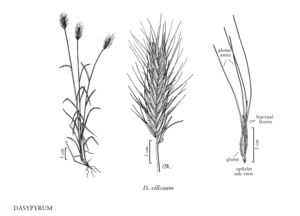| Taxon | Illustrator ⠉ | |
|---|---|---|
 | Dasypyrum villosum | Cindy Roché |
Plants annual or perennial; shortly rhizomatous if perennial. Culms 20-100 cm. Sheaths open; auricles present, often inconspicuous; ligules 0.3-1 mm, membranous, truncate; blades 1-5 mm wide, flat, linear, central vein distinct on the abaxial side. Inflorescences terminal spikes, 4-12 cm long including the awns, 0.6-2 cm wide excluding the awns, compressed, dense, with 1 spikelet per node; rachis internodes flat, margins ciliate, hairs white; middle internodes 1-3 mm; disarticulation in the rachises, at the nodes beneath each spikelet. Spikelets 25-75 mm including the awns, 7-22 mm excluding the awns, more than 3 times the length of the rachis internodes, usually divergent, sometimes ascending, laterally compressed, with 2-4 florets, the lower 2 florets usually bisexual, the terminal florets sterile; rachilla internodes below the lower florets shorter than those below the terminal florets. Glumes equal, to 40 mm including the awns, to 8 mm excluding the awns, coriaceous, usually 5-veined, strongly 2-keeled, keels with 1-3 mm hairs, margins unequal, stiff, translucent, apices tapering into scabrous awns; bisexual lemmas 9-13 mm excluding the awns, lanceolate, keeled, usually 5-veined, apices acuminate, awned, awns to 60 mm; sterile lemmas smaller, awns to 10 mm; paleas narrowly lanceolate, membranous, 2-veined, 2-keeled; lodicules 2, free, membranous, ciliate or glabrous; anthers 3, 4-7 mm, yellow; ovaries pubescent; styles 2, free to the base, x = 7. Haplome V.
Discussion
Dasypyrum is a Mediterranean genus of two species; only one has been collected in the Flora region. The hairy, 2-keeled glumes make the genus easily distinguishable from other genera in the Triticeae.
Selected References
Lower Taxa
"decumbent" is not a number."+timesthelengthof" is not declared as a valid unit of measurement for this property.